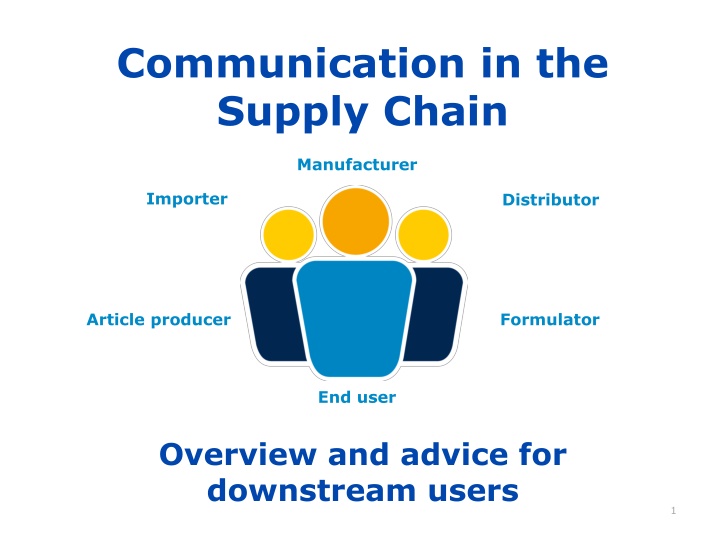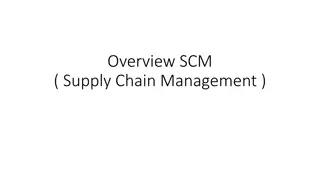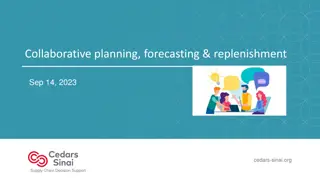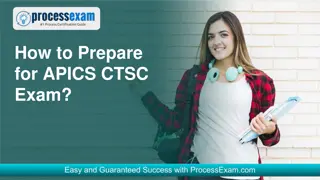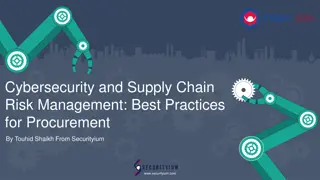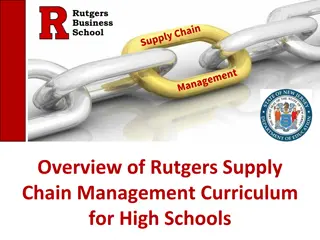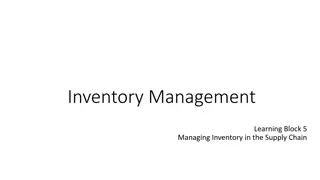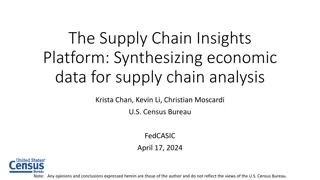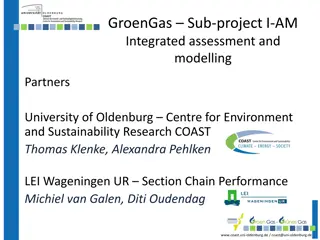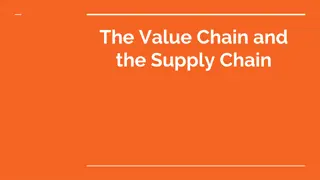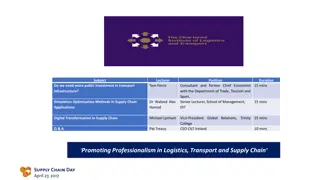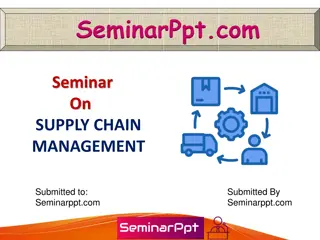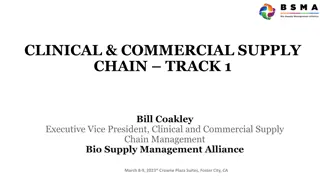Effective Communication in Supply Chain for Downstream Users
This presentation by ECHA provides insights on communication within the supply chain, aimed at aiding downstream users in understanding REACH and CLP Regulations. It covers topics such as communication flow, information exchange, and actions to take upon receiving exposure scenarios. The emphasis is on improving communication for better safety practices and compliance with regulations.
Download Presentation

Please find below an Image/Link to download the presentation.
The content on the website is provided AS IS for your information and personal use only. It may not be sold, licensed, or shared on other websites without obtaining consent from the author.If you encounter any issues during the download, it is possible that the publisher has removed the file from their server.
You are allowed to download the files provided on this website for personal or commercial use, subject to the condition that they are used lawfully. All files are the property of their respective owners.
The content on the website is provided AS IS for your information and personal use only. It may not be sold, licensed, or shared on other websites without obtaining consent from the author.
E N D
Presentation Transcript
Communication in the Supply Chain Manufacturer Importer Distributor Article producer Formulator End user Overview and advice for downstream users 1
Purpose of this presentation This presentation, with notes, was prepared by ECHA, the European Chemicals Agency, to assist you in preparing a presentation about REACH and CLP Regulations relating to downstream users. The intention is that you can select relevant slides and modify them as necessary to suit your audience, whether it is management, workers, environmental health and safety professionals, authorities etc. You may use it without additional permission. This presentation gives a brief overview of how communication in the supply chain can work effectively. A related presentation how to check the exposure scenario gives more specific advice related to the actions for downstream users when they receive exposure scenarios. They form part of a series of presentations relating to downstream users and REACH/CLP, which are on the ECHA website. We welcome your comments and suggestions at downstream_users@echa.europa.eu. Legal notice: The information contained in this presentation does not constitute legal advice and does not necessarily represent in legal terms the official position of the European Chemicals Agency. The European Chemicals Agency does not accept any liability with regard to the contents of this document. Release: May 2015, Last update: July 2019 2
Contents Communication flow in the supply chain Information in the supply chain What to do when you receive exposure scenarios 3
Communication flow in the supply chain 4
Communication flow in the supply chain Upstream Downstream Manufacturer Importers Formulator Information on uses Information on safe use Formulator End user Users of articles 5
Communication up the supply chain Better information to suppliers results in better advice on safe use from suppliers If you have new information on hazards or inappropriate risk management measures in the safety data sheet you must communicate it to your supplier Sector Use Maps 7
Sector Use Map Package - Background Aims and objectives To develop a harmonised, effective way for downstream users to inform registrants on how substances are used To provide a basis for relevant and realistic assessments To promote useful advice on safe use of chemicals To provide information that can be readily processed by registrants using IT tools To communicate on a sector-wide basis and avoid time-consuming communication with individual downstream users To provide DUs with harmonised ES from different registrants based on proposed standard phrases Status Based onUse template by DUCC (2009) Templates finalised and published first half of 2016 By July 2019, 10 industry sectors have published their use map files 8
Sector Use Maps - Format Provides overview of the common uses in a sector arranged by life cycle stage (manufacture, formulation or re=packing, use at industrial sites etc.) Each use is described by a use name and some market information The ES short title for communication is included The contributing activities for each use are given The corresponding links to exposure assessment inputs are given. These provide the conditions of use to be used when preparing an exposure assessment for the contributing activity. Example: Widespread use by professional workers of a cleaning product might include contributing activities for workers of manual spraying and wiping, and for the environment (indoor use) 9
Sector Use Maps - Inputs For each contributing activity in a Use Map, links are provided to exposure assessment inputs for workers, consumers and the environment Exposure assessment inputs Workers Workers: Sector-specific Worker Exposure Description (SWED) Use map SWED Use description Consumers Consumers: Specific Consumer Exposure Determinant (SCED) SCED Environment Environment: Specific Environmental Release Category (SPERC) SpERC 10
The formulator role Communication down the Supply Chain Formulator receives extended safety data sheets for substances from his suppliers Identifies and consolidates relevant advice to provide for safe use of the mixture Provides safety data sheets for hazardous mixtures to downstream users, together with consolidated information on safe use Customers receive clear, relevant information so they can use the mixtures safely 11
The safety data sheet (SDS) REACH defines When a SDS must be provided What to do when you receive a SDS What a SDS should contain What is the format of a SDS When exposure scenarios should be annexed Classification and labelling information must be provided in accordance with the CLP Regulation 13
When a safety data sheet (SDS) should be provided Substance or mixture is classified as hazardous Substance is PBT/vPvB Substance is on Candidate List Non-classified mixture contains certain substances above specified limits (on request) When substance or mixture is hazardous SDS are not required for the general public but sufficient information for safe use must be provided It is sold to downstream user(s) If a substance or mixture is sold to both downstream users and general public, SDS need not be supplied, unless requested by downstream user or distributor Or it has been requested 14
When exposure scenarios should be provided For mixtures, the supplier may communicate the information from exposure scenarios for ingredient substances in other ways When it is a substance and registered > 10 tonnes/year A chemical safety assessment is not required for quantities <10 tonnes / year Exposure scenarios are generated only for hazardous substances and it is hazardous 15
Valid reasons for having a SDS without exposure scenarios annexed Substance is: not hazardous exempt from registration registered as an intermediate under strictly controlled conditions registered below 10 tonnes/year SDS is: Safety Data Sheet provided on a voluntary basis for a mixture 16
Format and Content of the SDS Main body according to REACH Annex II, including: Classification and labelling information Registered uses Threshold values for exposure (OELV, DNEL, PNEC) Physicochemical data Toxicological and eco- toxicological data Exposure scenarios include: Use-specific operational conditions Use-specific risk management measures Exposure estimates Additional advice 17
Information in the supply chain Activities are taking place as part of the ENES programme to improve the information generated and provided Chemical safety assessment Ensuring assessments are accurate, realistic and relevant, and based on sector information on good practices Harmonisation of format and content, incl. table of contents Development of standard phrases (ESCom Package) Annotated templates and examples Automated IT communication Exposure scenarios Mixtures Developing agreed methodologies to identify and communicate safe use information of mixtures 18
What to do when you receive exposure scenarios 19
What to do when you receive ES Check that your use and customer use is covered Check that the conditions of use match your actual conditions Take necessary actions If you have data indicating that applying Exposure Scenario leads to unsafe use, inform your supplier and take actions to control the risks 20
What to do when you receive ES and you are a formulator Check that your own use and your customer use are covered Check if you have received ESs covering your use and uses by your customers Provide on request if non- classified mixture contains certain substances above specified limits Provide a SDS to downstream users for a hazardous mixture Communicate information on safe use of the mixture from ES You have several options 21
Communicating information on mixtures 22
Why good communication matters Good communication in the supply chain Registrant Saves time End User Saves money Distributor Can be good for business Protects human health and the environment Article Producer Formulator 23
Information for Downstream users on the ECHA website The technical, scientific and administrative aspects of REACH and CLP are managed by ECHA, the European Chemicals Agency. Web pages containing information specifically aimed at Downstream users have been tagged Downstream user . Click the tag to retrieve the list of relevant content. echa.europa.eu/regulations/reach/downstream-users 24
